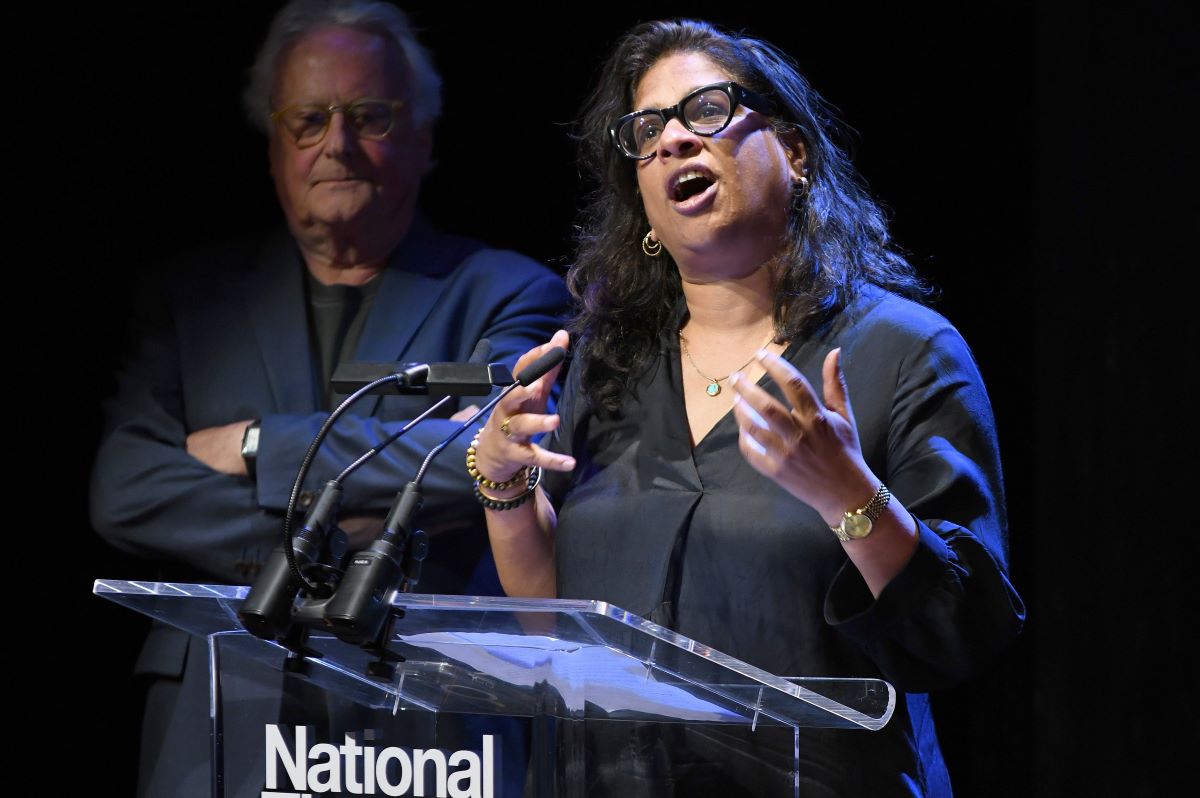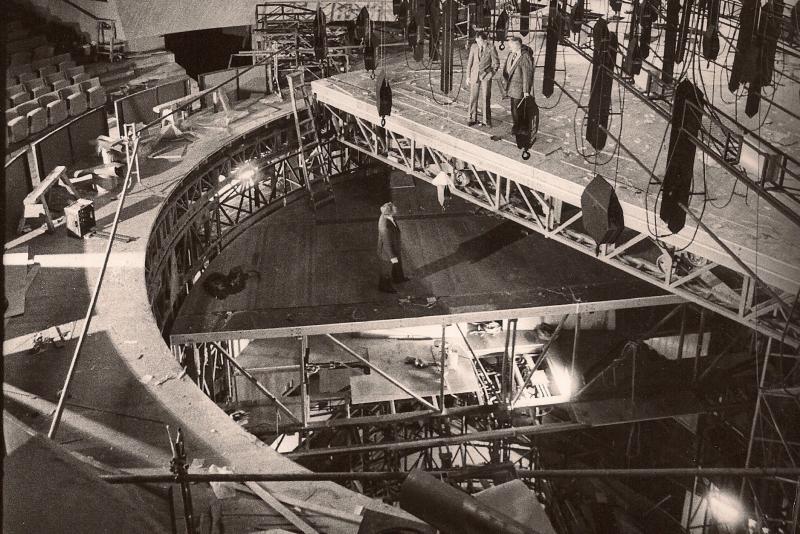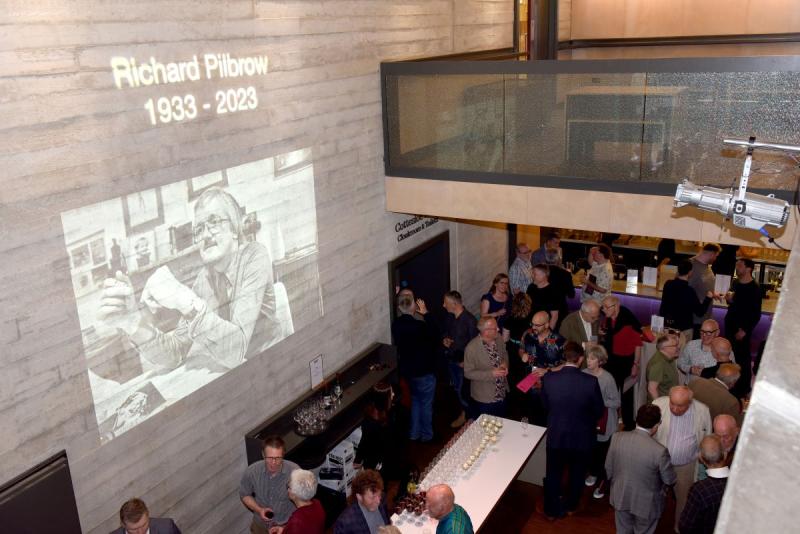
Current and past National Theatre Directors Indhu Rubasingham and Richard Eyre address the audience celebrating the life of Richard Pilbrow at the Dorfman Theatre
Photo: Justin Piperger
A sense of theatre
A new book by the late Richard Pilbrow explores how the National Theatre came about and how it laid the groundwork for future theatres. Rob Halliday is its co-Editor.
There is little doubt that the National Theatre’s Dorfman auditorium was the perfect place for the celebration of the life and work of the pioneering lighting designer and theatre consultant Richard Pilbrow.
In part, that was because the Dorfman did exactly what it had been designed to do: pack an audience of 400 people – friends, colleagues, admirers, family – tightly around the stage, connecting them intimately with the speakers and performers and with each other, giving a thrilling sense of togetherness, of community.
In part, that was because the theatre’s design came from Richard’s company Theatre Projects – not from the National’s architect Denys Lasdun – reflecting his long involvement with every aspect of the National’s creation from the moment Laurence Olivier asked the then thirty-year-old Pilbrow to light the National’s very first show.
Interface between architecture and theatre
And Richard’s involvement with the place never really ended. From lighting shows he became involved in conversations about the new building. In time he was invited to join the Building Committee. Olivier had assembled the leading names in British theatre of the day to help formulate what kind of theatres the new building should contain, and then to choose – and work with – an architect to design and build them.
Once Denys Lasdun was selected as that architect, Richard became the interface between architecture and theatre, ultimately as the building’s theatre consultant.
In that role, he and his team at Theatre Projects led the construction of a working theatre quite unlike any ever before seen in Britain, unafraid to adopt technology to enable the ambitious proposed rep schedule. There was to be not just a different show each night in each auditorium but ideally a show on stage rehearsing in the morning, a matinee of a second and an evening performance of a third.
Innovations included the first power flying system in British theatre and the Olivier’s famous drum revolve stage, able to corkscrew scenery up from the basement to stage level three floors above – either in changeover or as spectacular parts of the show itself. And then there was the pioneering Lightboard – a computerised lighting control system – and countless other technical innovations now so commonplace and standard we forget somewhere did them first. Many of those firsts were at the National.
Continues…
 The Olivier Theatre drum revolve under construction. Photo: Philip Sayer
The Olivier Theatre drum revolve under construction. Photo: Philip Sayer
Committed to technological innovation
While getting all that technology to work was challenging – particularly in that winter of discontent with three-day weeks, galloping inflation and a push to just get the building open ready or not – work it ultimately did. Triumphantly, giving generations of creative artists powerful tools to help tell their stories.
The National has remained committed to innovation ever since. It has often pioneered new technologies such as video projection that have gone on to become standard in theatrical design language. And it has updated its equipment, to keep it current and to move to lower-energy versions where possible.
Its new £125m Stories Start Here fundraising campaign, kick-started by £26.4m from government, is intended to continue this, in particular with upgrading the behind-the-scenes infrastructure so vital to making this technology work. The Dorfman will close from mid-November to allow this to happen.
In search of the ‘magical’ formula
While Richard was proud of the technology created for the National, he was never quite satisfied with the designs of the two bigger theatres – the Olivier and the Lyttelton. As an experienced theatre practitioner – a lighting designer and a producer of shows such as the original Fiddler on the Roof and Company – the larger spaces didn’t feel ‘magical’ to him. So began his quest to work out how to get that magic back into new theatres.
The refurbishment of Theatre Royal Nottingham provided a clue. Olivier had obsessed about the maximum distance from actor to furthest audience member. He’d sent people out to measure that distance in his favourite theatres and the result – 65 feet – became the guiding principle of the National’s design.
At Nottingham, Richard realised it was about getting the maximum number of people as close to the actor as possible, noting that while the Olivier and Theatre Royal Drury Lane have the roughly same volume, Drury Lane fits almost twice as many people into that volume. His simple summary: the audience had to hug the stage. That fuelled the design of countless wonderful auditoria around the world.
Continues…
 Foyer of the Dorfman Theatre where the celebration of Richard Pilbrow's life was held in May. Photo: Justin Piperger
Foyer of the Dorfman Theatre where the celebration of Richard Pilbrow's life was held in May. Photo: Justin Piperger
Who’d build a violin out of concrete?
Nine years ago, he set out to write a book exploring these issues at the National, but it didn’t feel right just to be negative about those theatres. Notwithstanding Albert Finney’s famous remark asking who’d build a violin out of concrete, many people – actors, audience, show makers – love all of the National’s theatres, and remarkable productions have been made in them.
So instead, Richard’s book – A Sense of Theatre – became an exploration of how the National’s theatres came to be the way they are, quoting at length from the minutes of the Building Committee. He also explores how the theatres have been used in the almost forty years since the building opened, including interviews with a variety of theatre makers from Judi Dench to Stephen Daldry; and how the theatres, in particular the Dorfman, have inspired or shaped theatres that have come after them.
Richard died last December; his name was projected on the side of the National as a mark of respect to someone who had been such an influential figure in its creation and who had been working right to the end to ensure the history of the building would be available to subsequent generations.
Rob Halliday is a lighting designer and programmer.
![]() www.robhalliday.com | theatreprojects.com/
www.robhalliday.com | theatreprojects.com/
![]() @NationalTheatre | @TheatreProjects
@NationalTheatre | @TheatreProjects
A Sense of Theatre: The Untold Story of Britain’s National Theatre is available for purchase from Unicorn Publishing Group.
Join the Discussion
You must be logged in to post a comment.